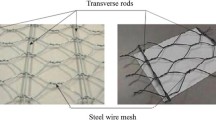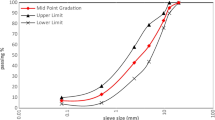Abstract
To understand the improving effects of graphene content and its adding methods on pavement performance and self-healing behaviors of asphalt mixture, the dimethyl sulfoxide-pretreated graphene (DG) was chosen as the modifier material to prepare asphalt mixture. Wheel tracking test, moisture susceptibility test, three-point bending beam test, and semi-circular bending test were selected to characterize pavement properties and self-healing behaviors of base asphalt mixture, asphalt mixture prepared by replacing filler with DG (DAM-1), and asphalt mixture prepared by DG-modified asphalt (DAM-2). Also, the influences of the adding method of DG on asphalt mixture properties were evaluated. Results indicate that deformation resistance, anti-cracking, and moisture susceptibility of asphalt mixture are improved after adding DG. The surface temperatures of DAM-1 and DAM-2 are raised by the stronger wave absorption property and thermal conductivity of DG, which accelerate the diffusion of asphalt in the cracking interface and enhance the fracture energies, toughness indices, and self-healing efficiencies of DAM-1 and DAM-2. As the fracture–healing cycle times is increased, self-healing efficiencies all show a reduction, and the largest decrease of self-healing efficiency is shown after the fourth fracture–healing cycle. The self-healing efficiency is affected by the toughness and flow diffusion area of asphalt during the microwave heating. Considering pavement performance and self-healing efficiency of asphalt mixture, it is proposed to prepare graphene-modified asphalt mixture using DG-modified asphalt.








Similar content being viewed by others
References
Guo, R., Zhou, F., & Nian, T. (2022). Analysis of primary influencing factors and indices distribution law of rutting performance of asphalt mixtures. Case Studies in Construction Materials., 16, e01053. https://doi.org/10.1016/j.cscm.2022.e01053
Gao, L., Kong, H., Deng, X., & Wang, Z. (2022). Multi-scale finite element simulation of asphalt mixture anti-cracking performance. Theoretical and Applied Fracture Mechanics, 121, 103490. https://doi.org/10.1016/j.tafmec.2022.103490
Sreeram, A., Masad, A., Nia, Z., Maschauer, D., Mirwald, J., Hofko, B., & Bhasin, A. (2021). Accelerated aging of loose asphalt mixtures using ozone and other reactive oxygen species. Construction and Building Materials, 307, 124975. https://doi.org/10.1016/j.conbuildmat.2021.124975
Guo, R., Zhang, H., & Tan, Y. (2022). Influence of salt dissolution on durable performance of asphalt and self-ice-melting asphalt mixture. Construction and Building Materials, 346, 128329. https://doi.org/10.1016/j.conbuildmat.2022.128329
Eltwati, A., Mohamed, A., Hainin, M., Jusli, E., & Enieb, M. (2022). Rejuvenation of aged asphalt binders by waste engine oil and SBS blend: Physical, chemical, and rheological properties of binders and mechanical evaluations of mixtures. Construction and Building Materials, 346, 128441. https://doi.org/10.1016/j.conbuildmat.2022.128441
Ren, S., Liang, M., Fan, W., Zhang, Y., Qian, C., He, Y., & Shi, J. (2018). Investigating the effects of SBR on the properties of gilsonite modified asphalt. Construction and Building Materials, 190, 1103–1116. https://doi.org/10.1016/j.conbuildmat.2018.09.190
Crucho, J., das Neves, J., Capitao, S., & de Picado-Santos, L. (2019). Evaluation of the durability of asphalt concrete modified with nanomaterials using the TEAGE aging method. Construction and Building Materials, 214, 178–186. https://doi.org/10.1016/j.conbuildmat.2019.04.121
Vamegh, M., Ameri, M., & Naeni, S. (2020). Experimental investigation of effect of PP/SBR polymer blends on the moisture resistance and rutting performance of asphalt mixtures. Construction and Building Materials, 253, 119197. https://doi.org/10.1016/j.conbuildmat.2020.119197
Li, X., Wang, Y., Wu, Y., Wang, H., Chen, M., Sun, H., & Fan, L. (2021). Properties and modification mechanism of asphalt with graphene as modifier. Construction and Building Materials, 272, 121919. https://doi.org/10.1016/j.conbuildmat.2020.121919
Wang, R., Yue, M., **ong, Y., & Yue, J. (2021). Experimental study on mechanism, aging, rheology and fatigue performance of carbon nanomaterial/SBS-modified asphalt binders. Construction and Building Materials, 268, 121189. https://doi.org/10.1016/j.conbuildmat.2020.121189
Zhu, J., Zhang, K., Liu, K., & Shi, X. (2019). Performance of hot and warm mix asphalt mixtures enhanced by nano-sized graphene oxide. Construction and Building Materials, 217, 273–282. https://doi.org/10.1016/j.conbuildmat.2019.05.054
Guo, T., Wang, C., Chen, H., Li, Z., Chen, Q., Han, A., Jiang, D., & Wang, Z. (2019). Rheological properties of graphene/tourmaline composite modified asphalt. Petroleum Science and Technology, 37(21), 2190–2198. https://doi.org/10.1080/10916466.2019.1624375
Le, J., Marasteanu, M., & Turos, M. (2020). Mechanical and compaction properties of graphite nanoplatelet-modified asphalt binders and mixtures. Road Materials and Pavement Design, 21(7), 1799–1814. https://doi.org/10.1080/14680629.2019.1567376
Fakhri, M., & Shahryari, E. (2021). The effects of nano zinc oxide (ZnO) and nano reduced graphene oxide (RGO) on moisture susceptibility property of stone mastic asphalt (SMA). Case Studies in Construction Materials, 15, e00655. https://doi.org/10.1016/j.cscm.2021.e00655
Chen, Q., Wang, C., Qiao, Z., & Guo, T. (2020). Graphene/tourmaline composites as a filler of hot mix asphalt mixture: Preparation and properties. Construction and Building Materials, 239, 117859. https://doi.org/10.1016/j.conbuildmat.2019.117859
Nazki, M., Chopra, T., & Chandrappa, A. (2020). Rheological properties and thermal conductivity of bitumen binders modified with graphene. Construction and Building Materials, 238, 117693. https://doi.org/10.1016/j.conbuildmat.2019.117693
Bhasin, A., Bommavaram, R., Greenfield, M., & Little, D. (2021). Use of molecular dynamics to investigate self-healing mechanisms in asphalt binders. Journal of Materials in Civil Engineering, 23(4), 485–492. https://doi.org/10.1061/(ASCE)MT.1943-5533.0000200
Gonzalez, A., Valderrama, J., & Norambuena-Contreras, J. (2019). Microwave crack healing on conventional and modified asphalt mixtures with different additives: An experimental approach. Road Materials and Pavement Design, 20(sup1), 149–162. https://doi.org/10.1080/14680629.2019.1587493
Gulisano, F., Crucho, J., Gallego, J., & Picado-Santos, L. (2020). Microwave healing performance of asphalt mixture containing electric arc furnace (EAF) slag and graphene nanoplatelets (GNPs). Applied Sciences, 10(4), 1428. https://doi.org/10.3390/app10041428
Li, C., Wu, S., Chen, Z., Tao, G., & **ao, Y. (2018). Improved microwave heating and healing properties of bitumen by using nanometer microwave-absorbers. Construction and Building Materials, 189, 757–767. https://doi.org/10.1016/j.conbuildmat.2018.09.050
Xu, S., Liu, X., Tabakovic, A., & Schlangen, E. (2020). A novel self-healing system: Towards a sustainable porous asphalt. Journal of Cleaner Production, 259, 120815. https://doi.org/10.1016/j.jclepro.2020.120815
Zhu, H., Yuan, H., Liu, Y., Fan, S., & Ding, Y. (2020). Evaluation of self-healing performance of asphalt concrete for macrocracks via microwave heating. Journal of Materials in Civil Engineering, 32(9), 04020248. https://doi.org/10.1061/(ASCE)MT.1943-5533.0003332
Zhu, X., Ye, F., Cai, Y., Birgisson, B., & Lee, K. (2019). Self-healing properties of ferrite-filled open-graded friction course (OGFC) asphalt mixture after moisture damage. Journal of Cleaner Production, 232, 518–530. https://doi.org/10.1016/j.jclepro.2019.05.353
Zhu, X., Ye, F., Cai, Y., Birgisson, B., & Yu, Y. (2020). Digital image correlation-based investigation of self-healing properties of ferrite-filled open-graded friction course asphalt mixture. Construction and Building Materials, 234, 117378. https://doi.org/10.1016/j.conbuildmat.2019.117378
Phan, T., Park, D., & Le, T. (2018). Crack healing performance of hot mix asphalt containing steel slag by microwaves heating. Construction and Building Materials, 180, 503–511. https://doi.org/10.1016/j.conbuildmat.2018.05.278
JTG E20–2011. (2011). Standard test methods of bitumen and bituminous mixtures for highway engineering. Ministry of transport of China.
JTG F40–2004. (2004). Technical specifications for construction of highway asphalt pavements. Ministry of transport of China.
JTG E42–2005. (2005). Test methods of aggregate for highway engineering. Ministry of transport of China.
Xu, Z., Wang, H., & Xu, T. (2022). Bituminous modifier selection and effects of dimethyl sulfoxide pretreated graphene contents on bituminous properties. Construction and Building Materials, 343, 128145. https://doi.org/10.1016/j.conbuildmat.2022.128145
AASHTO R 30. (2005). Mixture conditioning of hot mix asphalt (HMA). American Association State Highway Transportation Officials.
AASHTO TP 124-16. (2016). American Standard method of test for determining the fracture potential of asphalt mixtures using semicircular bend geometry (SCB) at intermediate temperature. American Association State Highway Transportation Officials.
Iftikhar, S., Shah, P., & Mir, M. (2023). Potential application of various nanomaterials on the performance of asphalt binders and mixtures: A comprehensive review. International Journal of Pavement Research and Technology., 16, 1439–1467. https://doi.org/10.1007/s42947-022-00207-5
Zhang, C., Shi, F., Cao, P., & Liu, K. (2022). The fracture toughness analysis on the basalt fiber reinforced asphalt concrete with prenotched three-point bending beam test. Case Studies in Construction Materials, 16, e01079. https://doi.org/10.1016/j.cscm.2022.e01079
He, J., **ao, H., & Chen, X. (2023). Homogeneity of asphalt mixture at mesoscopic level based on DEM simulation and low-temperature splitting test. International Journal of Pavement Research and Technology, 16, 1583–1598. https://doi.org/10.1007/s42947-022-00214-6
Singh, D., Kuity, A., Girimath, S., Suchismita, A., & Showkat, B. (2020). Investigation of chemical, microstructural, and rheological perspective of asphalt binder modified with graphene oxide. Journal of Materials in Civil Engineering, 32(11), 04020323. https://doi.org/10.1061/(ASCE)MT.1943-5533.0003385
Zhang, K., Luo, Y., Chen, F., & Han, F. (2020). Performance evaluation of new warm mix asphalt and water stability of its mixture based on laboratory tests. Construction and Building Materials, 241, 118017. https://doi.org/10.1016/j.conbuildmat.2020.118017
Khiavi, A., & Asadi, M. (2022). Effect of specific heat capacity of aggregates and nano-graphite on self-healing of hot mix asphalt under microwave radiation. Construction and Building Materials, 328, 127091. https://doi.org/10.1016/j.conbuildmat.2022.127091
Lu, S., Kong, L., & Du, J. (2023). Influence of microwave absorbing agents on microwave deicing of concrete road. International Journal of Pavement Research and Technology, 16, 1073–1078. https://doi.org/10.1007/s42947-022-00181-y
Li, C., **ao, M., Dong, J., Ren, J., & Guo, X. (2023). Study on the factors affecting the self-healing performance of asphalt mixture and pavement based on fracture mechanics and calculation formula. Theoretical and Applied Fracture Mechanics, 126, 103954. https://doi.org/10.1016/j.tafmec.2023.103954
Han, M., Muhammad, Y., Wei, Y., Zhu, Z., Huang, J., & Li, J. (2021). A review on the development and application of graphene based materials for the fabrication of modified asphalt and cement. Construction and Building Materials, 285, 122885. https://doi.org/10.1016/j.conbuildmat.2021.122885
Wang, L., Shen, A., Wang, W., Yang, J., He, Z., & Tang, Z. (2022). Graphene/nickel/carbon fiber composite conductive asphalt: Optimization, electrical properties and heating performance. Case Studies in Construction Materials, 17, e01402. https://doi.org/10.1016/j.cscm.2022.e01402S
Acknowledgements
We would like to thank Advanced Analysis & Testing Center of Nan**g Forestry University for the assistance in experiments.
Funding
This study is supported from National Natural Science Foundation of China, China (no. 51978340), Postgraduate Research & Practice Innovation Program of Jiangsu Province, China (no. KYCX21_0885), and A Project Funded by the National First-class Disciplines (PNFD).
Author information
Authors and Affiliations
Contributions
ZX: Data curation, Investigation, Methodology, Roles/Writing—original draft and Formal analysis. TX: Writing—review and editing, Conceptualization, Funding acquisition, and Project administration.
Corresponding author
Ethics declarations
Conflict of interest
The authors declare that they have no known competing financial interests or personal relationships that could have appeared to influence the work reported in this paper.
Rights and permissions
Springer Nature or its licensor (e.g. a society or other partner) holds exclusive rights to this article under a publishing agreement with the author(s) or other rightsholder(s); author self-archiving of the accepted manuscript version of this article is solely governed by the terms of such publishing agreement and applicable law.
About this article
Cite this article
Xu, Z., Xu, T. Improving Effects of Pretreated Graphene on Pavement Performance and Self-Healing Behaviors of Asphalt Mixture. Int. J. Pavement Res. Technol. (2023). https://doi.org/10.1007/s42947-023-00401-z
Received:
Revised:
Accepted:
Published:
DOI: https://doi.org/10.1007/s42947-023-00401-z




